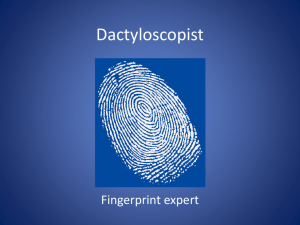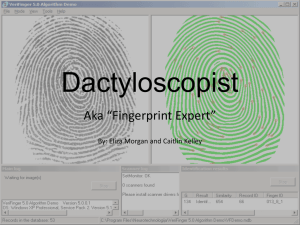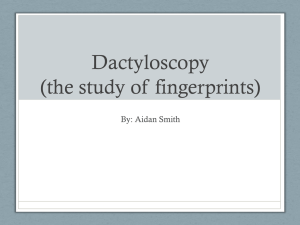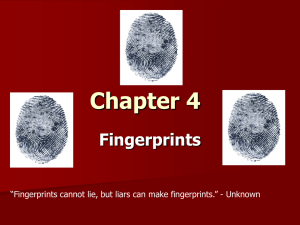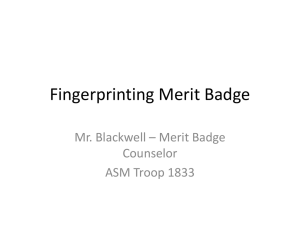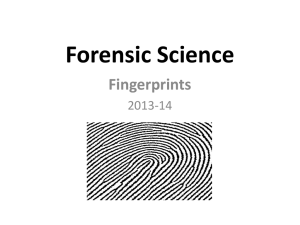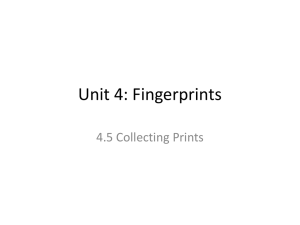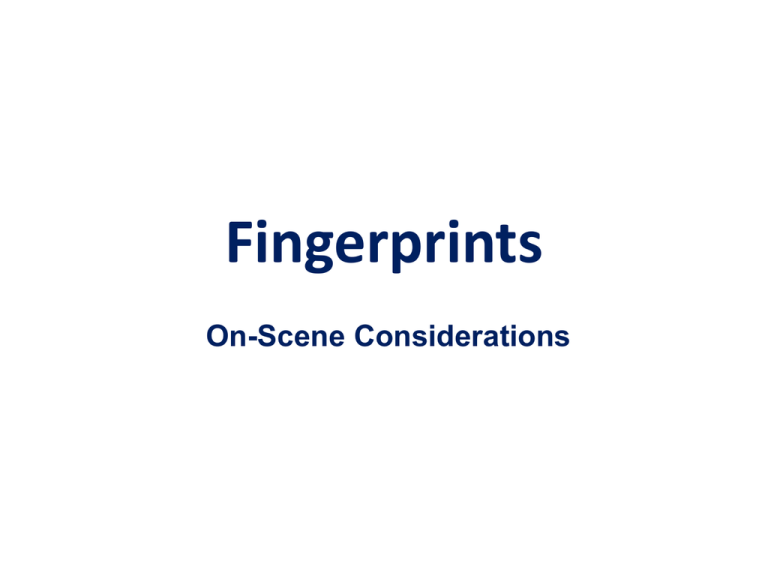
Fingerprints
On-Scene Considerations
Types of Fingerprints
Latent Prints
Patent Prints
Smudged
Invisible
Visible
Treatments to Visualize
Enhancement
Generally Surface Dependent
Plastic Prints
Malleable Surface
Chewing gum
Wet soap
Candy
Types of Fingerprints
Patent Prints
Contamination
Positive Transfer
Blood
Dust
Soot
Oils
Prints of the Ridges
Patent prints
Prints in Dust
Capturing prints in dust
Lift dust with gel or electrostatic lifter
removes some of the material leaving a void which is
visible
Question – if a finger is pressed onto a dusty surface
and lifted using a gel or electrostatic lifter, what is
lifted and what remains?
Types of Fingerprints
Plastic Prints
Fresh print
Substances that melt easily or soften
Chocolate
Adhesive tape
Thick layers of dust
Plastic explosives
Putty
Candle/sealing wax
Fats/flour/soap/sticky oily films/tar/pitch/clay
Negative Transfer
Prints of the Grooves
WHY?
Plastic prints
A type of Patent print
•
Negative impression of ridge
formation
– Results from contact of finger with
soft substance
• Clay, fresh paint
– Ridges impressed into surface
– Creates negative impression of
the ridges
– Ridges are deeper than
surrounding area
• Photograph with oblique
lighting & close-up lens
before further processing
• Cast of impression can be
made @ lab
– First spray with release agent
– Cast impression with silicone
casting material: Mikrosil
– Cast can be made at scene
Cast Print from Soap
Plastic Print
Finger Presses into Chewing gum
+
Groove of
Fingerprint
Ridge of
Fingerprint
Negative Print
Chewing Gum
Presses into
Soft Gum
Not Pressed
into Soft Gum
Latent Prints
Invisible Prints
Found on non-porous & porous surfaces
Smooth or textured surfaces
Paper
Fabrics
Metals
Plastics
Visible only after development
Latent Prints
Latent Prints
Fingers Covered with small amount of
grease/sweat/dirt transferred to surface
as a ridge impression
Contamination
Blood
Dust
Soot
Oils
Positive Transfer
WHY?
What is the difference
between a Latent &
Patent Prints?
Exemplars
Inked/Digital Prints from Known Persons
Digitized Scans from Glass
Inked Impressions
person’s fingers & thumbs in ink and then pressed onto a
fingerprint card
Toes & soles of feet also yield prints
Palm prints can be valuable
Fingerprint cards can be classified
Manually
Modified Henry System
Other classification systems
Semi-automatically
AFIS/IAFIS
Information from
Fingerprints
Time print had been on surface?
No – not reliably
Check when surface last cleaned
o Method had to have removed existing fingerprints
Sex, race or occupation?
No – not reliably
IR imaging
Fatty Acid analysis
Drugs
Classifying Fingerprints
Classifying Fingerprints Historically
The Henry System
1
2
3
4
5
6
7
8
9
10
Left
little
Left
ring
Left
middle
Left
index
Left
thumb
Right
little
Right
ring
Right
middle
Right
index
Right
thumb
Numerator
Left little
1
Left middle
2
Left thumb
4
Right ring
8
Right index
16
Denominator
Left ring
1
Left index
2
Right little
4
Right middle
8
Right thumb
16
Odd-numbered fingers count for the numerator.
Even-numbered fingers count for the denominator.
If a whorl appears on a finger, the value in the box is added to either the numerator or the
denominator.
The primary classification is calculated using these values and then adding 1 to both
numerator and denominator.
The values for the primary classification may then range from 1/1 (zero whorls) to
32/32 (10 whorls).
Comparing Latent Fingerprints
With Exemplars
Fingerprint Identification
The Basis of Comparison
Fingerprint Classification
AFIS
Searches millions of
records in relatively short
time.
Provides a list of possible
matches
Still need a person to
make the final ID
Manually compares
10 best matches
AFIS
How It Works
Fingerprint Quality at the Scene
Deposition Mechanism and Other Factors
Nature and cleanliness of Environment
Weather conditions
surface
Sweat glands more
Amount of contaminant
active in warm
Pressure applied
weather
o Heat
Movement during
o Humidity
transfer
o Freeze-thaw cycles
Condition of the friction
» Fragmented by
condensing
ridge detail
moisture
Finding Fingerprints at the Scene
Latent and patent fingerprints can be
anywhere and everywhere.
The problem is locating those that
are latent and then developing
them.
Transportable evidence with
fingerprints should be taken to the latent
print laboratory.
Some prints need to be developed @
the scene
Creates the problem of finding
fingerprints with probative value.
Scene dictates where to find
probative fingerprints. Waste of time to.
memorize the list … most important
items there are the last two points on
the right :
Use your imagination
Be the burglar (perpetrator). This is
when a search for probative prints pays
off.
The Scene is the Ultimate Guide
• Point of entry
– Broken entry
• Prints (including
shoe prints)
– Lock
– Immediate
surrounds
– Window
• Pieces of broken
glass
– May have blood
– May have been
tossed aside to
conceal entry
• Windowsill window
jam
• Tables used to
support weight
• Floor where burglar
knelt
Trace the path
Where eaten/drink
Glass & china are good targets of
prints
Can discard gloves
Light switches
Circuit breakers/fuses/light bulbs
loosened
Areas where gloves were a
hindrance
Toilet-flush lever
Tools left behind
Flashlight batteries
Latex gloves
General surfaces
Fabrics
Use your imagination …
BE THE BURGLAR
Search is an intellectual exercise. The thought
process might go something like,
“What
would I touch if I were the
scumbag who did this?
Fingerprints occur in three forms:
latent (invisible),
patent (visible) and
impression or plastic
Sub-category of patent
prints
Ridge detail impressed
into a malleable material is
visible.
Smudged prints
Sub-category of latent and
patent prints,
Little or no discernible
friction ridge detail.
DNA from smudged prints …
will be increasingly important as
investigative tool.
Types of Fingerprints
Latent Prints
Patent Prints
Smudged
Invisible
Visible
Treatments to Visualize
Enhancement
Generally Surface Dependent
Plastic Prints
Malleable Surface
Chewing gum
Wet soap
Candy
Developing
What method should be used?
Physical techniques as simple as
powder dusting
Complex chemical treatment, such as
superglue fuming or lanthanide chemistry.
A special light source that causes the
fingerprint residue to fluorescence;
Argon or Hd:YAG laser (2) or an
Alternate Light Source (ALS).
Fingerprint Components
Goal: Obtain as many prints as possible
Mostly Water
Soluble Substances
Latent Print
Mostly Water
Insoluble Substances
Water Insoluble Substances: Fat, Oils
Water Soluble
Water resistant: proteins, urea, lipoproteins
Trapped water soluble: amino acids, proteins, salts, etc
Both Water Soluble
And Insoluble Substances
Eccrine Sweat
Inorganics
• Sodium:
• Potassium:
• Calcium:
• Iron:
• Chloride:
34-266 mEq/l
4.9-8.8
3.4
1-70 mg/L
0.52-7 mg/mL
Organic
• Amino acids:0.3-2.59 mg/L
• Proteins:
15-25 mg/dL
• Glucose:
0.2-0.5
• Lactate:
30-40 mM
• Urea: 10-15
• Pyruvate:
0.2-1.6
Miscellaneous
• Fatty Acids
• Sterols:
0.01-0.1 ug/mL
0.01-0.12
•
•
Enzymes
Immunoglobins
•
•
•
•
•
•
•
•
•
•
Fluoride
Bromide
Iodide
Bicarbonate
Phosphate
Sulfate
Ammonia
Magnesium
Zinc
Copper
Sebaceous Sweat Secretions
OrganicS
• Triglycerides
30-40%
• Free fatty acids
15-25%
– Saturated - 50
– Monounsaturated - 48
– Polyunsaturated - 2
• Wax esters
20-25%
• Squalene
10-12%
• Cholesterol
1-3%
• Cholesterol esters 2-3%
Trace organics
• Aldehydes
• Ketones
• Amines
• Amides
• Alkanes
• Alkenes
• Alcohols
• Phospholipids
• Pyrroles
• Pyridines
• Piperidenes
• Pyrazines
• Furans
• Haloalkanes
• Mercaptans
• Sulfides
Anatomical Variation
After 12 hr Accumulation
Site
Forehead
Cheek
Chest
Back
Arm
Side
Leg
Total Lipid
288
144
122
84
76
57
57
CH
CE
1.1
1.1
2.7
3.4
TG
DG
FA
WE
SQ TG+DG+FA
29.6 3.5 27.2 25.9 10.1
39.4 2.7 15.4 26.9 11.2
29.7
24.9 25.7 10.3
60.3
57.5
60.0
57.8
55.1
56.6
56.3
Preserving Fingerprints
Print types that populate scenes can unleash a cascade of developmental
choices, many of which can be confusing to a student or a novice
investigator.
Patent print May require nothing more than photography followed by
a lifting method.
Partial print Requires well thought out strategy for enhancing what
is visible and what is not (the latent part of the print).
If the print is plastic, that is, impressed into a soft surface, the best
method might be to cast it using a silicone-based material.
Resulting cast can be enhanced in the laboratory.
If the evidence is transportable, techniques are available in the laboratory
that might be better suited because the conditions there are controlled.
Preserving Patent Fingerprints
One investigator has written that photography of patent and plastic prints is sufficient to
capture the detail necessary to make comparisons,
Of the three types of fingerprints, visible (patent) fingerprints can be photographed
directly.
Impression fingerprints can usually be photographed under special lighting conditions.
Only the latent fingerprints are difficult to photograph. They must first be made visible.
Following that advice could lead to failure.
Patent prints exist: Contamination from an exogenous source, such as blood, oils, cosmetics,
etc.
Photographing as sole means of archiving patent prints captures only that which is
visible. What is missed, is invisible.
It is critical to understand that patent prints can have a latent component.
Enhancing these should include a well thought out strategy designed to enhance all
potential ridge detail present in the deposited fingerprint.
Knowing how to develop fingerprints … requires understanding chemistry of fingerprint
reside. This means understanding the origin of the fingerprint residue.
Origin of Fingerprints
Print Residue: mixture of secretions
Sweat glands, skin cells, exogenous contaminants –
blood, oils, cosmetics, etc.
Although seems simple - because the components of
glandular secretions are known - it is complicated.
Sweat glands not all present on fingers or feet … friction
ridge skin.
Generally, fingerprint residue contains primarily water
soluble and/or insoluble substances.
Sudiferous glands
Secrete directly onto the friction ridge skin
Apocrine & Merocrine Sweat Glands
Both Have myoepithelial cells
Contract & squeeze
Causing discharges, left on the surface of the
skin.
Apocrine Glands
Scent glands that respond to emotional stress.
Begin functioning at puberty and produce
moisture during emotional experiences when someone is upset, frightened, or
experiences pain.
Active when a person is sexually stimulated.
… most numerous in the armpits (axillae), groin
associated with hair follicles and in the regions
around the nipples (areoles). …
Not historically forensically important,
especially with respect to locating latent
fingerprints at the crime scene.
These secretions are a viscous and cloudy and
potentially acted on by bacteria to produce a
noticeable odor.
Location suggests a potential forensic role in
sexual assault investigations.
Merocrine gland
Eccrine sweat glands: throughout the body
… more numerous than apocrine glands.
Approximately three million Eccrine glands
…
Most numerous on the palms and soles
- approximately (3000 glands per square
inch.
Densities range from 60 per cm2 on
the thigh to 350 per cm on the forehead.
Coiled structures lying deep within the
second dermal layer of the skin, the dermis.
Empties onto the skin surface,
Specifically on the epidermal ridges of
the friction ridge skin.
Not associated with hair follicles.
Responds to elevated body temperature
due environmental heat or physical exercise
Produces profuse sweating on hot
days or when physically active
Noticeable on palms and soles when
emotionally stressed.
Secretions have forensic value with respect
to fingerprint development.
Holocrine Gland - Sebaceous Gland:
Secretions are oily substances from broken cells known as sebaceous
cells,
Produce globules of a fatty material that accumulate inside the
cell causing them to swell and burst.
The resulting mixture of fatty material and cellular debris on the
skin is called "sebum,"
Found on all areas of the skin EXCEPT the friction ridge skin.
Sebum most prominent on the forehead and areas where
there is hair.
Secretions … eccrine, apocrine and sebaceous glands form the
fingerprint residue left at the crime scene.
Sweat Gland Summary
Each gland is located such that it does not occur in
the same locations on the body. Unlike eccrine glands,
sebaceous glands are not found on the friction ridge detail
skin – palmer regions of the hands, feet, fingertips, toes.
Sebaceous glands … Sebaceous contributions to
fingerprints occur when an individual touches regions of the
skin where these glands are plentiful, e.g., head, cheeks,
forehead, etc.
Apocrine glands … not secrete as much material as the
other two, and while they are located on all areas of the
body, they are most prominently associated with hair
follicles in the groin. Importantly, both sebaceous and
apocrine glands are associated with hair follicles but eccrine
glands are not.
Eccrine glands located on all regions of the body …
plentiful on the friction ridge skin – hands, palms and soles
of the feet … Always contribute to the fingerprint residue.
From a practical perspective, apocrine secretions contribute
to the print residue only if someone touches the groin area.
Fingerprint Residue
Each gland can contribute to
the overall chemistry of residue
Depends on the habits, stress
level and physical exertion of the
person leaving the print.
Continually runs fingers
through his scalp or
habitually touches his face or
forehead, … prints should
have an abundance of
sebaceous secretions.
Continually washing, his
prints might be cleaner, that
is, they should have a
relatively smaller amount of
sebaceous oils.
Sexual assault,
Assailant touches his or the victim’s groin
region … subsequently touches something at
the scene, say, a knife, the
Residue on the handle of the knife should
have an elevated level of apocrine secretions
relative to those from eccrine and sebaceous
glands.
Fingerprint Development
Experienced investigators recognize that the surface type dictates their approach to developing
fingerprints on-scene as well as in the laboratory. They employ techniques that work the best on
certain surface types. General considerations a logic-based decision process is suggested as a
effective approach for developing fingerprints.
Some authors of crime scene investigation texts barely treat the subject:
Henry Lee et. al. write the following.
“Physical methods are used for any dry, non-porous surfaces like glass
or plastic.”
For dry and wet surfaces, they write,
“Chemical processing methods for latent fingerprints can be used on dry
and wet surfaces.”
For latent prints on porous surfaces they caution,
“Latent prints on porous surfaces are visualized by the use of chemical
methods. Because of the nature of the surface and the fact that the friction
ridge secretions are dissolved into the surface, the chemical method chosen
for visualization must react with the secretions and not the surface.”
Fingerprint Development
Fisher considers each surface but instead of considering them as distinct topics,
he covers them broadly as entry-level discussions related to specific developing
techniques
Gardner goes into more detail and depth than either Lee or Fisher, considering
surfaces and the characteristics for porous surfaces, nonporous smooth and rough
surfaces and special surfaces.
Fish et al. discuss surfaces much like Fisher but adds a reference chart of
techniques published by the Chesapeake Bay Division of the International
Association of Identification to guide investigators. They do not explain, however,
how to use the techniques or the caveats involved with each.
The Chesapeake Bay Division of the IAI website lists reagents for use on
various surface types: Porous, non-porous, glass, plastic, wet, postcyanoacrylate, metal, adhesive tape, glossy paper, cartridge cases, raw wood,
post-Ninhydrin, and UV induced.
The website has links to the specific techniques. Each method considers the
pitfalls and formulations for the techniques and safety concerns.
Fingerprint Development
Fingerprint textbooks – Champod, et. Al.; Lee and Gaensslen discuss surfaces
and compatible techniques in detail.
The most comprehensive compilation of development techniques is published
by The British Home Office (Home Office Scientific Development Branch – HOSDB),
whose manual titled, Manual of Fingerprint Identification Development Techniques
covers fingerprint development techniques and surfaces for which they are
compatible. The manual presents workable schematics – cascades - for employing
various techniques in sequence.
Charts outline a sequential approach to print development, including
primary, special, and secondary routes of analysis.
Still, the British approach is surface-based, which is clear from the following
quote.
“The surface on which fingerprints are to be developed should normally
determine the sequence of processes to be used, except for fingerprints
contaminated with blood...”
Students and novice investigators … choosing specific development method for
specific application can be confounding, especially if there are significant resources
available.
Aging of Fingerprints
Surfaces
Water
Insoluble Substances
Amino Acids
Porous
Migration slowed
by Paper
Diffusion
Urea, salts, etc
Water sol. Deposits (WSD) absorbed within seconds
Water evaporates over time
Leaves mixture of residues behind
Amino acids
o Stabilize
o Minimal migration < 80% RH
Urea & chlorides
o Migrate continuously
Slower @ RH < 80% minimal @ first week
Penetration into substrate depends on relative Humidity (RH)
Older prints have significant diffusion of urea & chlorides
Blurred images w/respect to these components
Paper evidence
Can pinpoint terrorist activities, forgeries and/or provide
investigative information in major crime investigations.
Critical vehicle leading to a successful prosecution.
Paper defined as a porous surface & is usually treated as
porous for developing latent prints.
However, there are caveats to this approach.
Porous surfaces absorb fingerprint residue. Because of that,
they must be treated differently than nonporous or nonabsorbent ones.
The issue is that papers absorb fingerprint residue
to varying degrees and amounts,
Determined by the paper’s absorption
characteristics as well as humidity, temperature and
the environment.
For this reason, porous surfaces can be classified
into groups based on how quickly they absorb print
residue.
Some papers are considered “hard” and often have a
glossy sheen.
They typically do not absorb fingerprint residue
readily or quickly. … glitzy magazine cover,
Choice of fingerprint development method different than
for highly absorptive paper where residue penetrates easily
and quickly.
Porous Surfaces
Aging of Latent Prints
Porous Surface
Emulsion
Of Water
Soluble & insoluble Substances
Porous Surface
Water
Insoluble Substances
Water
Soluble Substances
Water
Insoluble Substances
Amino Acids
Migration slowed
by Paper
Diffusion
Urea, salts, etc
Research on Porous surfaces
Depth and shape of the fingerprint residue penetrating the porous
material. 15 types of paper and the diffusion of amino acids present in the
fingerprint residue.
Goal to understand how residue penetration varied with porosity,
smoothness and density of the paper versus quality of the developed
prints.
Penetration varied considerably from paper-to-paper – least penetration to
most - according to the following progression: brown wrapping paper, smooth
copier paper, the inner side of an envelope, writing paper, copier, outer side of
an envelope, cotton paper and postcard board.
Inverse relationship between penetration and the smoothness of the paper
Direct relationship with porosity.
Best quality was obtained when the print residue penetrated the porous
matrix to a depth of between 40-60 microns.
40 microns = .00157480315 inches
Very shallow and very deep penetrations correlated with poorer quality
prints.
Looking at only the amino acids which are water soluble substances. They did
not examine the oily sebaceous secretions of the residue.
Implications of the Research
Changed then existing paradigm of how to think about
developing latent prints on porous surfaces.
Divided porous surfaces into two broad categories,
Smooth, relatively non-absorbent papers:
Development techniques compatible with nonporous surfaces.
Highly absorbent papers foster deeper penetration:
A development strategy for developing the Eccrine
print components, e.g., amino acids.
Print Development Cascades
Development methods done a specific
sequence such that each step will not affect
print development with subsequent steps.
All ofany
the above
Can be stopped at
time
Cannot go backward in the cascade
Step 1
Technique 1
Step 2
Technique 1
Prints
developed
Step 3
Technique 2
Prints
developed
Step 4
Prints
developed
Prints
developed
Alternative Suggested Development
Cascade for Porous Surfaces
Low Penetration
Paper
Optical Detection
SG Fuming Dusting Lanthanide
Staining Dusting
High Penetration
Paper
Optical Detection
Indanedione
DFO
Luminescence
Ninhydrin
Absorption Mode
Nano-gold deposition
Zn++/Cd++ Salts
Luminescence
Luminescence
Physical Developer
Physical Developer
Nonporous Surfaces
At most crime scenes non-porous surfaces are the
most plentiful,
Makes them important candidates for developing latent
fingerprints at crimes scenes: burglaries, homicides,
sexual assaults, stolen vehicles, etc.
Research for new methods for developing fingerprints …
dizzying array of techniques … the choice can be confusing
for students, novice investigators and experienced scene
investigators.
What happens to prints on nonporous surfaces?
The most important is what happens as the print ages.
Aging of Latent Prints
Non-porous Surfaces
Emulsion Of Water Soluble
& insoluble Substances
Nonporous Surface
Dehydration
Over Time
Oxidation of Oils
Nonporous Surface
Days-Weeks-Months After Deposition
Fingerprint residue dehydrates
over time … quick or slow
depending on the surface
characteristics & environment.
Emulsion eventually dries
Nonreactive chemicals
Print residue emulsion
stabilized by the glycerides present.
Dry emulsion: Water phase
no longer present
Changes the chemical
environment of the print
residue.
The residue present but
is no longer an emulsion.
Can rehydrate emulsion
using acetic acid or ammonia
vapors
Other effects … oxidation,
pollution, dust, etc, … affect the
fingerprint residue and gives
development problems.
Drying Fingerprint Emulsion
Effects of Drying on Print Emulsion
New – oily print
Emulsion Fresh and
Aqueous Phase Present
Old – oily print
Emulsion Dry
Print emulsion
Print emulsion Gone
Normally stabilized by
Water, fatty acids &
Mono, di & triaglycerides
Aqueous phase
no longer present
Hygroscopic material in oily latent print
explains regeneration of superglue fumed aged
prints at high humidity levels in an atmosphere
of acetic acid or ammonia vapors
Drying
•Print emulsion disrupted
•Temperature
•Humidity
•Air currents
•Exposure to sun
•Nature of surface
•Clarity Affected by
•Dust
•Pollution
•Bacterial action
Print Clarity
•Oxidation
•Emulsion decomposition
•Diffusion into surface
What Happens?
Print Dries
Loss of stickiness
Narrowing of print
ridges
Loss of continuity
along print ridges
Avg. Lifetime of Sweaty vs. Greasy
Latent Prints on Nonporous Surfaces
Outdoors (days)
Indoors (weeks)
Print
Type
Gland
Origin
Glass
Mtal
Plastic
Glass
Mtal
Plastic
Sweaty
Eccrine
5.8
4.2
3.3
12.2
10.1
7.5
Greasy
Sebaceous
25.8
20.5
19.5
73.2
47.6
28.2
4.5x
4.8x
5.9x
5.9x
4.7x
3.8x
Comparison
Developing Fingerprints on
Nonporous Surfaces
Cascades
A Nonporous (Hard Surface)
Development Cascade
Dry Surface
Wet Surface
Optical Detection
Optical Detection
Dusting Lanthanide Superglue Fuming
Small Particle Reagent
Reflective mode
CTF - SolidVacuum Metal Deposit
State Acquisit.
Reflective mode
Observation & recording
In luminescence mode
Reflective mode
Reflective = examining with ALS or flashlight in oblique mode
Luminescence = examining with ALS in fluorescence mode

